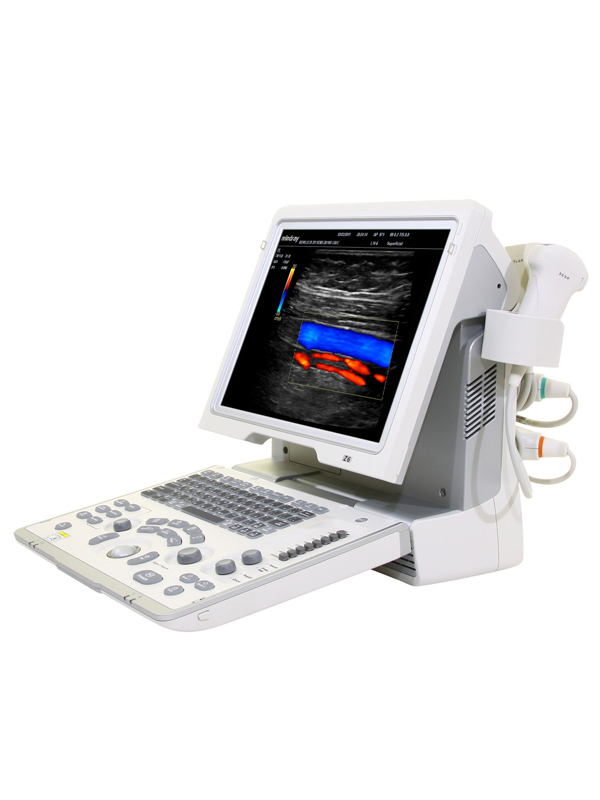ECG Machine is the process of recording the electrical activity of the heart over a period of time using electrodes placed on the skin. These electrodes detect the tiny electrical changes on the skin that arise from the heart muscle‘s electrophysiologic pattern of depolarizing and repolarizing during each heartbeat. It is very commonly performed to detect any cardiac problems.
In a conventional 12-lead ECG, ten electrodes are placed on the patient’s limbs and on the surface of the chest. The overall magnitude of the heart’s electrical potential is then measured from twelve different angles (“leads”) and is recorded over a period of time (usually ten seconds). In this way, the overall magnitude and direction of the heart’s electrical depolarization is captured at each moment throughout the cardiac cycle.[4] The graph of voltage versus time produced by this noninvasive medical procedure is an electrocardiogram.
During each heartbeat, a healthy heart has an orderly progression of depolarization that starts with pacemaker cells in the sinoatrial node, spreads out through the atrium, passes through the atrioventricular node down into the bundle of His and into the Purkinje fibers, spreading down and to the left throughout the ventricles. This orderly pattern of depolarization gives rise to the characteristic ECG tracing. To the trained clinician, an ECG conveys a large amount of information about the structure of the heart and the function of its electrical conduction system.[5] Among other things, an ECG can be used to measure the rate and rhythm of heartbeats, the size and position of the heart chambers, the presence of any damage to the heart’s muscle cells or conduction system, the effects of cardiac drugs, and the function of implanted pacemakers.
The etymology of the word is derived from the Greek electro, because it is related to electrical activity, kardio, Greek for heart, and graph, a Greek root meaning “to write”.
Alexander Muirhead is reported to have attached wires to a feverish patient’s wrist to obtain a record of the patient’s heartbeat in 1872 at St Bartholomew’s Hospital.[7] Another early pioneer was Augustus Waller, of St Mary’s Hospital in London.[8] His electrocardiograph machine consisted of a Lippmann capillary electrometer fixed to a projector. The trace from the heartbeat was projected onto a photographic plate that was itself fixed to a toy train. This allowed a heartbeat to be recorded in real time.
An initial breakthrough came when Willem Einthoven, working in Leiden, the Netherlands, used the string galvanometer (the first practical electrocardiograph) he invented in 1901.[9] This device was much more sensitive than both the capillary electrometer Waller used and the string galvanometer that had been invented separately in 1897 by the French engineer Clément Ader.[10] Einthoven had previously, in 1895, assigned the letters P, Q, R, S, and T to the deflections in the theoretical waveform he created using equations which corrected the actual waveform obtained by the capillary electrometer to compensate for the imprecision of that instrument.
Using letters different from A, B, C, and D (the letters used for the capillary electrometer’s waveform) facilitated comparison when the uncorrected and corrected lines were drawn on the same graph.[11]Einthoven probably chose the initial letter P to follow the example set by Descartes in geometry.[11] When a more precise waveform was obtained using the string galvanometer, which matched the corrected capillary electrometer waveform, he continued to use the letters P, Q, R, S, and T,[11] and these letters are still in use today. Einthoven also described the electrocardiographic features of a number of cardiovascular disorders. In 1924, he was awarded the Nobel Prize in Medicine for his discovery.[12]
By 1927, General Electric had developed a portable apparatus that could produce electrocardiograms without the use of the string galvanometer. This device instead combined amplifier tubes similar to those used in a radio with an internal lamp and a moving mirror that directed the tracing of the electric pulses onto film.[13]
In 1937, Taro Takemi invented a new portable electrocardiograph machine.[14]
Though the basic principles of that era are still in use today, many advances in electrocardiography have been made over the years. Instrumentation has evolved from a cumbersome laboratory apparatus to compact electronic systems that often include computerized interpretation of the electrocardiogram.







Reviews
There are no reviews yet.